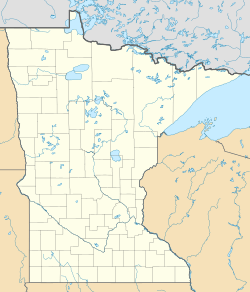Leavenworth, Minnesota facts for kids
Quick facts for kids
Leavenworth
|
|
|---|---|
| Country | United States |
| State | Minnesota |
| County | Brown |
| Township | Leavenworth Township |
| Elevation | 1,004 ft (306 m) |
| Time zone | UTC-6 (Central (CST)) |
| • Summer (DST) | UTC-5 (CDT) |
| ZIP code |
56087
|
| Area code(s) | 507 |
| GNIS feature ID | 646567 |
Leavenworth is a small, unincorporated community in Leavenworth Township, Brown County, Minnesota, United States. An unincorporated community means it's a place where people live, but it doesn't have its own local government like a city or town. It sits about 1,004 feet above sea level.
Leavenworth has a unique history. It was first located near the Cottonwood River before the Dakota War of 1862. After the war, the community moved to a new spot, also along the Cottonwood River.
Contents
History of Leavenworth
Early Settlers and Naming
Long ago, Native American groups like the Mississippi Indians lived in the Leavenworth area. They settled near rivers and lakes. These spots offered fish and water. The riverbanks also provided wood for fires.
Later, people began to homestead on the land. This meant they could claim land to live on and farm. Many of these early settlers also chose to live along the Cottonwood River.
Leavenworth was officially started on April 16, 1857. It was mapped out that same year. The community was likely named after Colonel Henry Leavenworth. He was a military commander who helped set up Fort Snelling in 1819.
John B. Calkins built a log cabin in Leavenworth around 1857. The next year, he became the postmaster, in charge of the local post office. Leavenworth was located along the Shetek Trail, an important wagon route.
Impact of the Dakota War
Leavenworth faced attacks early in the Dakota War of 1862. A group from New Ulm went to Leavenworth to check on people. They found settlers who had been killed and some wounded children. The wounded were sent back to New Ulm by wagon. However, the rescue party arrived in New Ulm during the Battles of New Ulm and was also attacked.
During August 1862, the Joseph Brown family and others were killed in Leavenworth Township. This happened on the Shetek Trail. A special marker now stands about one mile west of where Leavenworth is today. It tells the story of the Brown family during the war. Because of the conflict, the first location of Leavenworth was left empty.
A New Beginning for Leavenworth
After the war, settlers started a second Leavenworth community. This new settlement was on land owned by Rose and George Windschitl. It was also located along the Big Cottonwood River.
The settlers built many important businesses. These included a general store, a blacksmith shop, and a school. There was also a flour mill, a sawmill, a druggist, and a doctor. A church, called the Church of the Japanese Martyrs, was built in the 1860s. Today, a historic marker on County Road 24 shares information about this settlement.
Changes Over Time
In the 1870s, a new railroad line was built. However, it did not go through Leavenworth. This caused the town's population to shrink. By the mid-1880s, only a mill and a saloon were left as businesses.
The post office in Leavenworth closed and reopened a few times. It finally closed for good in 1902. Leavenworth did not grow much in the late 1800s and early 1900s.
However, in the 1930s and 1940s, the community still had some important places. These included two stores, the Mathiowetz shop, a rectory (where a priest lives), the Japanese Martyrs Church, a schoolhouse, and a cemetery. In 1953, a convent and a new school opened there, showing the community was still active.



